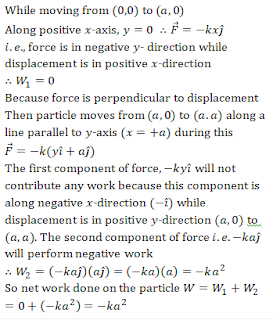Work power energy is the most important chapter when it comes to mechanics, for JEE (Advanced). The chapter is quite tricky and takes a lot of time and devotion on your part to understand and master. But this chapter is a complete gold medal for almost all the questions of the mechanics can be solved by the work power energy approach if you master this topic..
Q2.In the above questions, the work done by frictional force is
Solution
Work done by friction force is equal to negative of the work done by the coolies
Q4. A spring is compressed between two toy carts of masses m_1 andm_2. When the toy carts are released, the spring exerts on each toy cart equal and opposite forces for the same small timet. If the coefficients of friction μ between the ground and the toy carts are equal, then the magnitude of displacements of the toy carts are in the ration
Solution
Minimum stopping distance =s
Work done against the friction =W=μmgs
Initial momentum gained by both toy carts will be same
Because same force acts for same time Initial kinetic energy of the toy cart =(p^2/2m) Therefore, (μmgsp^2)/2m or s=(p^2/(2μgm^2 ))
For the two toy carts, momentum is numerically the same. Further μ and g are the same for the toy carts. So s1/s2 =(m2/m1 )^2
Work done against the friction =W=μmgs
Initial momentum gained by both toy carts will be same
Because same force acts for same time Initial kinetic energy of the toy cart =(p^2/2m) Therefore, (μmgsp^2)/2m or s=(p^2/(2μgm^2 ))
For the two toy carts, momentum is numerically the same. Further μ and g are the same for the toy carts. So s1/s2 =(m2/m1 )^2
Q5.Let r be the distance of a particle from a fixed point to which it is attracted an inverse square law force given by F=k/r^2 (k= constant). Let m be the mass of the particle and L be its angular momentum with respect to the fixed point. Which of the following formulae is correct about the total energy of the system
Q6. Two trucks A andB, one loaded and the other unloaded, are moving and have same kinetic energy. The mass of A is double that ofB. Brakes (providing same retarding force) are applied to both and are brought to rest. If the distance converted by A before coming to rest is s1 and that of B is s2, then
Solution
Work done by braking force=change in KE
-Fs=0-KEi ⇒s=(KEi)/F
KEi and F are same for both, Hence, s is also same for both
Q7.A force F=-K(yi+xj) (where K is a positive constant) acts on a particle moving in the xy-plane. Starting from the origin, the particle is taken along the positive x-axis to the point (a,0) and then parallel to the y-axis to the point (a,a). The total work done by the force F on the particles is
Q8.A lorry and a car moving with the same K.E. are brought to rest by applying the same retarding force, then
Solution
Stopping distance =(kinetic energy)/(retarding force)⇒s=1/2 (mu^2)/F
If lorry and car both possess same kinetic energy and retarding force is also equal then both come to rest in the same distance
If lorry and car both possess same kinetic energy and retarding force is also equal then both come to rest in the same distance
Q9. The energy required to accelerate a car from rest to 10 ms^(-1) is E. What energy will be required to accelerate the car from 10 ms^(-1) to 20 ms^(-1)?
Q10. A particle is projected with a velocity u making an angle θ with the horizontal. The instantaneous power of the gravitational force















